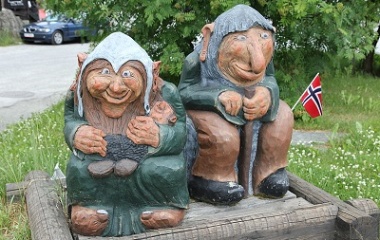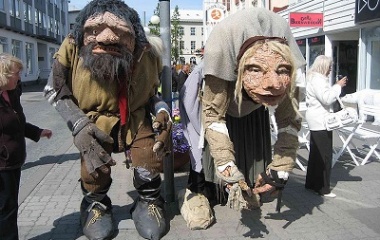Passing under the shadow of Norway or Sweden’s great mountain ranges, you might notice that the countryside is littered with boulders. These boulders didn’t arrive at their final resting place by accident. Many of them were weapons of the giant Trolls who once roamed the land—and a few of them have an even more spectacular history. They are the bodies of Trolls themselves, turned to stone because they were exposed to daylight.
What is a Troll?
Trolls are humanoid creatures who dwell deep in the wilderness of Scandinavia. Their appearance ranges from monstrous to eccentric to cute, but they are almost all unfriendly, no matter how charming they might look. Unless you are a quick-thinker, an encounter with a Troll never ends well.
Characteristics
Physical Description
Scandinavian folklore introduces two kinds of Trolls: the giants (often called jontar) and the little folk (often called huldrefolk).
The jotnar, who borrow their name and many of their characteristics from the ancient Norse ice giants, are superhuman characters. They tower above your average man, supported by colossal stony limbs. Their features are rugged, like stone worn down by the weather, and their hair is wild. Some of them are so large and unkempt that plants can even take root in their skin. The ugliest jotnar can have single eyes, like a cyclops, or multiple heads.
The huldrefolk are much less of an eyesore than their giant cousins. In fact, they can easily be mistaken for humans—and attractive humans at that! They are betrayed only by their tails, which can be cow-like or fox-like, but these can be hidden by clothing.
Lifestyle
Trolls, especially the jotnar, are primitive creatures. They isolate themselves from human civilization, preferring to live in caves or murky forests beyond the reach of man’s hustle and bustle.
Sometimes, a small community of Trolls can spring up in one area, but the beasts have little to no form of government even when they live together. At best, the strongest of them might be crowned as a “king,” who has the right to order the others around. Above all other social institutions, they dislike religion. Legend says that it was first Thor’s thunderbolts and then the ringing of church bells which drove them into exile, and they are still quick to attack travelling Christians, kidnap un-baptized children, or demolish churches when they can.
Some Trolls support themselves by hunting or farming, but far more of them are pillagers. They waylay travelers, strip them of their valuables, and perhaps even eat them. The most daring individuals might even launch an expedition into a village, destroying buildings, plundering treasure, and kidnapping children or beautiful ladies.
Special Abilities
Trolls are traditionally dim-witted creatures, so they aren’t in the habit of cultivating talents. The greatest skills they have are the skills they were born with: brute strength and a strong connection with nature. They can uproot trees to use as clubs and hurl boulders as missiles. The mightiest of them are capable of stirring up thunderstorms or avalanches.
Small Trolls are more advanced than their massive cousins, and they have more tricks up their sleeves. Female huldras, for example, have beautiful voices that mimic wind and falling water. They can lure men into the wilderness with their sweet songs. Others have minor magical abilities that can make humans fall asleep, lose track of time, see visions of treasure, etc.
Cultural Representation
Origin
Trolls date back all the way to ancient Norse and Viking culture, appearing in the oldest definitive text on Norse culture, the Prose Edda.
Still the evolution of the Troll, as a recognizable species, is confusing. Originally, the word trolleri was used to describe all sorts of creatures who drew their magic from nature and used it to mess with humans. It took hundreds of years for that name to narrow down to the creatures we recognize as Trolls today. Indeed, the sharp divide between the two types of Trolls we recognize today (one gigantic and aggressive, the other small, cute, and mischievous) is evidence of the past diversity of these creatures.
Modern Usage
Beginning with the Prose Edda, Trolls have marched relentlessly across the pages of literature. At first, they were limited to Scandinavian fairytales like “Askeladden’s Adventures” and “Three Billy Goats Gruff,” which highlighted their stupidity by allowing weaker characters to outsmart them. In the twentieth century, however, they received a slight character upgrade in John Bauer’s The Changeling, which depicts them as scheming creatures who are, at times, capable of being soft-hearted.
Not surprisingly, Scandinavia’s European neighbors adopted Trolls next. The monsters were especially popular with British fantasy writers, including CS Lewis, JRR Tolkein, and JK Rowling, all of whom preserved the unintelligent, ugly, and aggressive archetype.
In the United States, Trolls have received an unusual twist. They appear as small, lovable creatures who are especially fond of children, as in the movies Frozen and Trolls!. They are even popular as collectible toys, who are characterized by large, round noses and tall, fluffy piles of brightly colored hair.











Absolutely the female trolls are able to mimic the human voice as well! I camped in a place in France, I heard a voice singing in the forest at dawn. It was near a stream, that stream got out of a big rock by ground, dug in an enormous cliff. Here there are similar tales, but of course it is not called trolls but have others names like “rajadas” etc in my opinion, the event I witnessed was from a fairy because I saw the “sparkles” above the stream. It is a place rather difficult to access, a kind of cliff made of ground and one has to clutch to the tree roots to arrive at the final location. It was so logical that this area is filled with them because not often visited but the humans and they dislike our presence. When this “flying voice” was aware of me, she/he/they left immediately after.